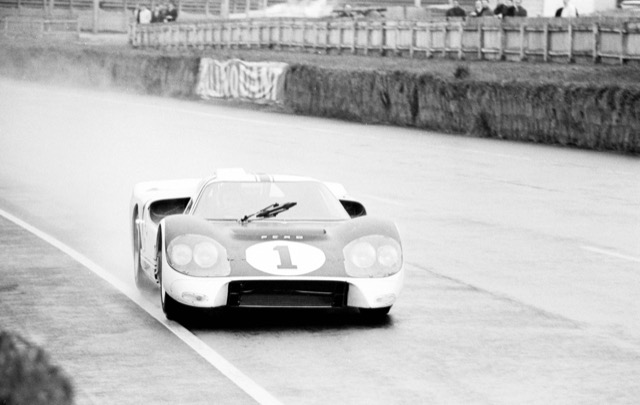A REIMAGINED IMSA SCHEDULE FOR 2018.
 Monday, October 2, 2017 at 08:26AM
Monday, October 2, 2017 at 08:26AM Editor's Note: Since this week is the 2017 IMSA WeatherTech SportsCar Championship season finale at Road Atlanta with the running of Petit Le Mans, we thought we'd leave Peter's column up another week since it deals with the IMSA schedule itself, even though one reader questioned his sanity for having the temerity to suggest moving Monterey Car Week (too bad, by the way). Peter will be back next week with a new "Fumes" column, but we do have other racing coverage in The Line. -WG
By Peter M. DeLorenzo
Detroit. Since my most recent column on revising NASCAR's schedule generated tremendous interest (much of it negative from the NASCAR community, which was to be expected), you would think that writing about the NASCAR circus would continue to be all-consuming. Hardly. While it's easy to target NASCAR for its head-in-sand refusal to acknowledge its ongoing downward spiral, everything is far from rosy in sports car racing, specifically the IMSA WeatherTech SportsCar Championship.
As someone who was exposed to road racing from an early age, it remains my favorite form of racing to this day. But given the myriad problems facing all of racing of late, including the unending quest for sponsors and the constant appeasement of manufacturers so that they stay interested and engaged, it's no wonder that I consider a hard look at the IMSA schedule to be worthwhile, and long overdue.
First of all, you have to understand that racers just want to race, so it's easy to see how a schedule evolves. The constant quest of finding sponsors consumes team principals and their marketing arms on a daily basis, so a locked-in schedule is a needed constant that is reassuring and something they don't necessarily want to have to think about. This is an understandable take to be sure, but it doesn't negate the fact that IMSA's schedule could be better, if serious consideration was put into it. This is in no way meant to denigrate the tremendous effort put forth by Scott Atherton & Co at IMSA, because their task of dealing with the individual tracks on the schedule, plus the promoters, manufacturers, sponsors and racing teams - not to mention the FIA and ACO - is a steady thrum of back-and-forth negotiations that is never ending.
But in order to accomplish a meaningful rethink of the schedule, it requires a major attitude adjustment, one that progresses beyond the, "we're just happy to have a race and be sponsored enough to compete" platitudes expressed by the competitors or the, "our schedule is locked-in even earlier this year so that our teams and sponsors can plan accordingly, which is huge for us," usually conveyed by IMSA management. Those two perspectives are certainly worthy and well-intentioned, but I think too much is being left on the table.
From my frame of reference, the recurring considerations for the sport of road racing in this country have to revolve around these two questions: What's best for the growth of the sport going forward? And how can a schedule be constructed to mine every advantage we have? So, let's take a look at what a reimagined 2018 IMSA schedule might look like:
January 19 - 21, Daytona Beach, Florida: The "Roar Before the Rolex 24" is moved to the weekend before the Daytona 24 hour race to reduce cost. Scheduling this exercise two weeks before the race is a giant boondoggle that blows up budgets and schedules, and it needs to end.
January 25 - 28, Daytona Beach, Florida: You don't mess with history, so the Daytona 24 Hour stays exactly where it belongs on the North American racing calendar.
March 14 - 17, Sebring, Florida: Speaking of history and tradition, America's oldest and most prestigious sports car race - the Twelve Hours of Sebring - stays put. In addition, both Daytona and Sebring would be put back on the international racing calendar and the WEC will not be allowed to run its own event at Sebring, which is pretty much the dumbest idea I've heard for racing in a very long time by the way.
April 13 - 14, Birmingham, Alabama: I really don't care about the hoary "happening" raison d'etre that defines the Grand Prix of Long Beach racing weekend. IMSA doesn't belong there functioning as the "Sideshow Bob" for IndyCar. This is one of those prime examples of just because it's available it doesn't mean the series should be racing there, so a trip to Barber Motorsports Park is in the offing instead.
May 4 - 6, Lexington, Ohio: Mid-Ohio was put back on the IMSA calendar for 2018 because it belongs there. I concur.
May 17 - 19, Charlotte, North Carolina: On the "roval" at Charlotte Motor Speedway one week before the Coca-Cola 600, replacing the NASCAR "all-star" race, which is a recurring joke. Have the teams bring some "extra" cars and put some NASCAR stars in them to liven up the proceedings too. And no, I'm not a fan of "rovals" per se but I'm even less of a fan of IMSA running at Belle Isle Park in Detroit. As well-intentioned as Roger Penske and GM are by being the prime movers behind that weekend, the fact remains that ingress and egress to and from the island remains a perennial issue. On top of that, this race qualifies as a true "CSS" ("Can's See Shit") event that confounds true racing enthusiasts every year it comes up on the calendar. I'm not a "homer" for this city and I am definitely not a booster of this event, and I question the true value of it every year that it is run. I wouldn't miss it in the least. And note how this date is moved up considerably. Why? See below.
June 13 - 17, Le Mans, France: Okay, so this is where the ACO - now that they've completely screwed up its event - falls on its sword and begs IMSA to bring its top prototype teams over to run the 24 Hours of Le Mans, including the DPi machines.
June 28 - July 1, Watkins Glen, New York: If you read up about genuine tradition in major league American road racing it's no secret why The Glen occupies a permanent place on the calendar.
July 6 - 8, Bowmanville, Ontario: Yes, of course, Canadian Tire Motorsports Park (aka Mosport) belongs on the calendar. It is a fantastic track and it is the home for some of the most rabid road racing fans in the world.
July 20 - 21, Lakeville, Connecticut: If I could find another natural-terrain road racing circuit to take the place of Lime Rock I certainly would, because even an all-GT race at this track is barely acceptable. But in lieu of doing that, Lime Rock stays.
August 3 - 5, Alton, Virginia: The Michelin GT Challenge at VIR makes a move up on the calendar to an earlier date.
August 17- 19, Salinas, California: IMSA's appearance at Laguna Seca (Mazda Raceway) is also moved up, a full three weeks earlier.
September 7 - 9, Elkhart Lake, Wisconsin: Road America, "America's National Park of Speed" and this country's greatest natural-terrain road racing circuit moves to a fall date as the second-to-the-last race on the IMSA calendar.
October 10 - 13, Baselton, Georgia: The IMSA finale at Road Atlanta - The Motul Petit Le Mans - remains as the climax of the American road racing season.
Yes, I know, the "roval" at Charlotte Motor Speedway is heresy, but I would take it all day long over another race on Belle Isle. Besides, it might perk up the crowds in Charlotte to witness something that's actually different than what they're used to seeing. Also, other than the obvious distance races at Daytona, Sebring, Le Mans, Watkins Glen and Road Atlanta, all other IMSA races would be cut to two hours total in length. More heresy? Not really. The two-hour-and-40-minute slog for the non-endurance races has outlived its usefulness. Make the IMSA TV coverage a two-and-one-half hour window allowing for a solid pre-race show and plenty of post-race coverage.
Are these schedule changes radical? Not as radical as I'd like them to be, but nonetheless a fresh perspective.
And that's the High-Octane Truth for this week.
Editor's Note: Many of you have seen Peter's references over the years to the Hydrogen Electric Racing Federation (HERF), which he launched in 2007. For those of you who weren't following AE at the time, you can read two of HERF's press releases here and here. And for even more details (including a link to Peter's announcement speech), check out the HERF entry on Wikipedia here. -WG
Publisher's Note: As part of our continuing series celebrating the "Glory Days" of racing, we're proud to present another noteworthy image from the Ford Racing Archives. - PMD

(Photo courtesy of the Ford Racing Archives)
Le Mans, 1966. Bruce McLaren testing the Ford J-car prototype during the practice day for the 24 Hours of Le Mans. After many test and development sessions, including one that took the life of the great Ken Miles at Riverside International Raceway, the J-car returned as the new Ford Mk IV to win the race in 1967 with Dan Gurney and A.J. Foyt behind the wheel.





